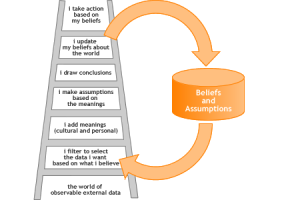I often like to make a distinction between caring and care-taking when it comes to leading others. This post, from 2011, gets more specific about what it means to care and why it’s important.
==================================================
 Benjamin Franklin once said, “Want of care does more damage than want of knowledge”
Benjamin Franklin once said, “Want of care does more damage than want of knowledge”
Never is that more true than in the workplace. Of course, there are those who continue to believe that caring for the people we lead is unimportant or a sign of weakness. After all, they would never accomplish anything if they had to spend all of their time worrying about everybody who works there. And others are often heard to say, and quite proudly too, that they take care of their people, which is a totally different thing.
The flaw in this kind of thinking is that caring for those under our charge isn’t about parenting. It is about inviting people to bring all of themselves to work every day and helping them give their best effort willingly to something that matters both to them and to the organization. I think it safe to say that engaging people in this way gets results. That makes it pretty important.
So, what does caring for people look like from a leader’s vantage point? Well, I have some thoughts about that. Here they are:
Judicious leaders care enough to…
Be interested in each person’s skills, talents and ambitions
This is a good place to start and is not dissimilar to taking inventory. You have to know what, and who, you’ve got before you can decide how you are going to help them use it and grow it for both individual and organizational benefit.
Be clear about their expectations:
No one can produce desired results if they are working with a murky set of expectations. So it is incumbent upon the leader who cares to be able to state what s/he expects, as simply and succinctly as possible and to ensure that the person to whom s/he is speaking understands those expectations in the way they were meant.
Tell hard truths
We are all familiar with times when it is easier to avoid the truth than to confront it. But, when someone is not performing well, it is essential for the leader to address it. This often requires some pretty uncomfortable discussions, and can result in equally painful decisions. Caring sometimes means helping others step up… or step off to something else.
Hold people accountable
So you’ve had the conversation. You and your colleague have come to an agreement about what s/he will accomplish and how you will support him/her. It sounds good and you both leave the room feeling good.
Caring leaders know that it doesn’t end there. Follow-up is necessary, first, because those under their charge may need some help. Second, they may need some encouragement. And finally, they may need some reminding about the commitments they’ve made. Holding people accountable for doing what they say they are going to do sends the message that their efforts matter to the success of the whole.
Risk their own vulnerability
Relationships, even those that are forged for professional reasons, are two-way propositions. Leaders who care and want to build strong connections with others are willing to share their own stories, something of themselves that makes them human. No one is a super-hero. If we try to be that, we don’t have time to concentrate on much else
Challenge people to stretch
Sometimes people are capable of going beyond what they have agreed to do, and yet, haven’t. Or, they are assigned something they believe to be too challenging for them, and don’t think they can do it. In either case, the leader who cares will provide a needed nudge, will challenge, cajole, encourage and inspire that extra effort that brings them over the top and helps them win.
Clear the way
Leaders who care will anticipate and provide needed resources. And, they will address obstacles that get in the way of success.
Let go
So by now you’ve made a heavy investment in someone’s development to the extent that s/he is now a top performer. It is natural to want to hang onto that person. After all, s/he is making a huge contribution to your results.
Letting go is hard but it’s also an important part of organizational, and personal, development. Those who go on to greater things will appreciate that you cared. Those who feel held back will quickly forget that you did. Besides in letting go, you get to….
Start Again
This may be good or bad news from a leadership perspective but the truth is that people come and people go. I like to believe that the person who has built a good reputation as a leader who cares attracts those who are willing to learn and to meet him or her halfway.
That’s what I think anyway. What do you think?








 “Love and compassion are necessities, not luxuries. Without them, humanity cannot survive.”~ His Holiness Tenzin Gyatso, the 14th Dalai Lama
“Love and compassion are necessities, not luxuries. Without them, humanity cannot survive.”~ His Holiness Tenzin Gyatso, the 14th Dalai Lama
 Some time ago,
Some time ago, 
